Early learning and childcare (ELC): provision for 1 and 2 year olds in Scotland
Summary of mapping work to understand current ELC provision in Scotland.
2. Mapping nationwide ELC provision for 1- and 2-year-olds in Scotland
2.1 Analysis of secondary data
2.1.1 Number of places per child in formal group-based settings
In Scotland, as of December of 2021, there were a total of 13,710 Early Learning and Childcare (ELC) places for 1-year-olds, 25,260 ELC places for 2-year-olds, 47,020 ELC places for 3-year-olds, and 54,100 ELC places for 4-year-olds across formal group-based settings. These numbers include both funded and non-funded places in nurseries, playgroups, children and family centres, out of school clubs, holiday playschemes and creches. Because the Care Inspectorate does not collect data disaggregated by age for childminders, the numbers listed above do not include places within childminder settings. Thus, the number of places above is an underestimation of the total number of places available in Scotland. However, these numbers are still significant indicators of the availability of ELC places and how they vary across age groups. While some of the variation between age groups is based on differences in the population, there is also a significant difference in the ELC places per child across age groups[3], with significantly fewer ELC places per child in formal group-based settings for younger children. Figure 1 shows the national average of ELC places in formal group-based settings per child by age group.
Alt:
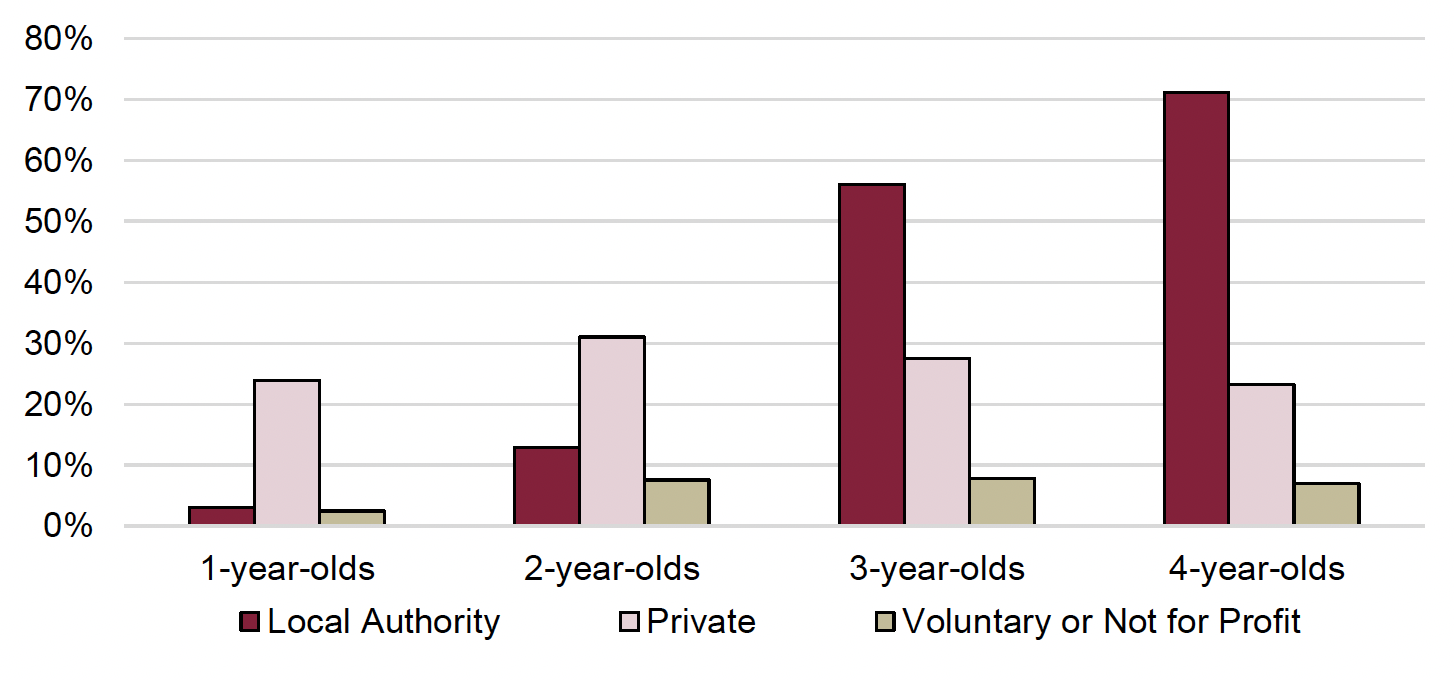
Source: Care Inspectorate Service List (December 2021), Office of National Statistics Population Estimates for Scotland
According to the Care Inspectorate Service List in December 2021, there were only 0.26 group-based ELC places per 1-year-old child and 0.47 group-based places per 2-year-old child compared to 0.89 group-based places per 3-year-old child, and 0.99 group-based places per 4-year-old child. While the Care Inspectorate data used above on the number of places does not include places within childminder settings, the data demonstrates that there are considerably fewer places for 1- and 2-year-olds than there are for older children. There are also significant differences in the number of places per child at the LA level, especially for 1-year olds.
The maps in Figures 2-4 demonstrate the variation in places per child in formal group-based settings across LAs and age groups. While it is difficult to draw a conclusion from the maps, they do indicate that in rural and remote councils, the number of ELC places in formal group-based settings per child is often lower than in urban councils. For example, in the Orkney Islands, the number of places per child for 1-year olds is only 0.11, while in the City of Edinburgh there are 0.45 places per child for the same age group. There is slightly less variation across councils in the number of places for 2-year-old children, however rural councils still have noticeably fewer places per child than urban councils. Once again, the Orkney Islands have the lowest number of places per 2-year-old child (0.15), and the City of Edinburgh has the highest number of places per 2-year-old child (0.64). A full table of places per child for each age group and LA is presented in Appendix 3. It is important to note that because childminders are not included in this map, and places in childminder settings vary by LA, the map may underestimate provision in some LAs more than others.
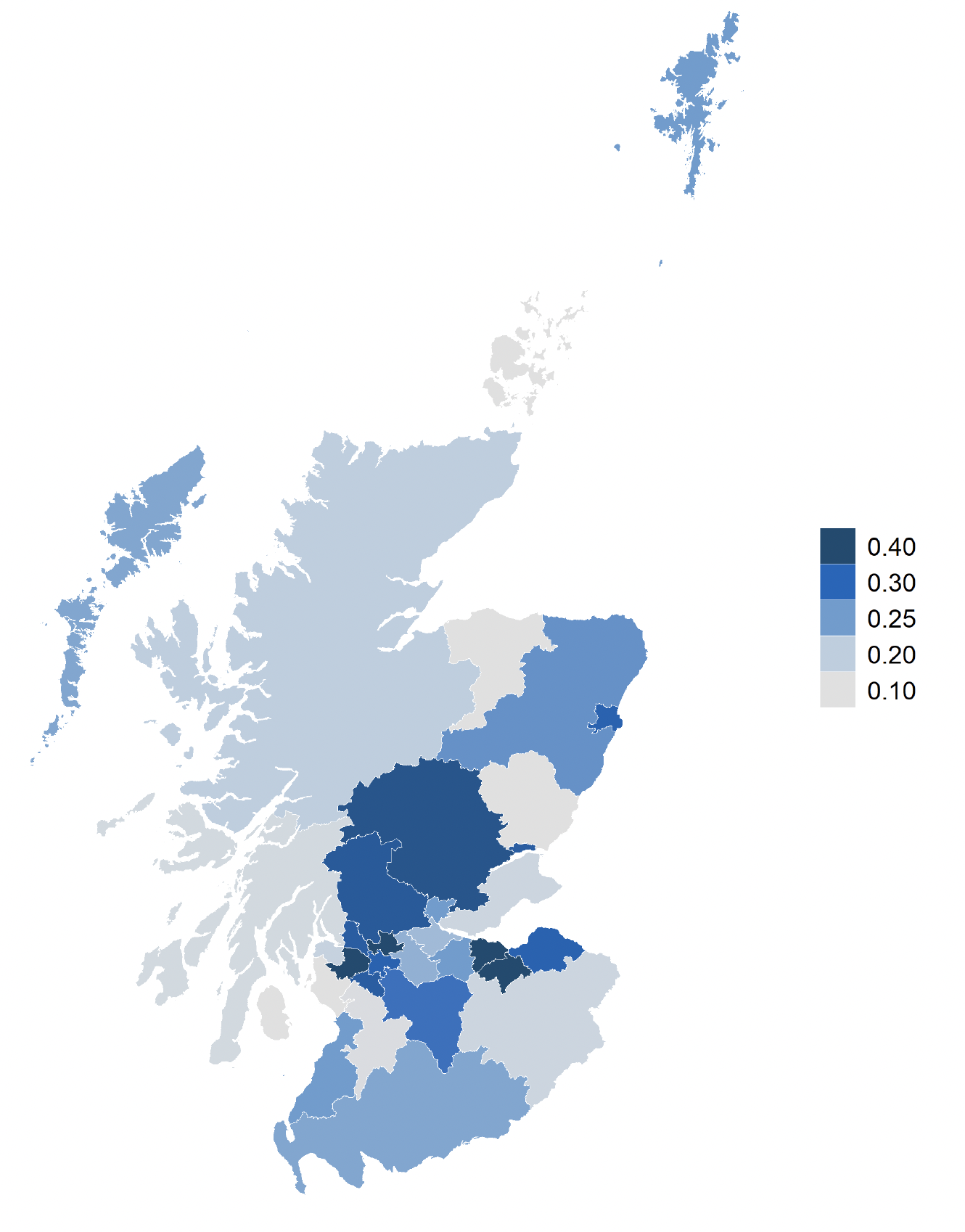 ELC places per child in formal group-based settings across Local Authorities in Scotland in 2021. The map focuses on places for 1-year-olds. The interval bands range from 0.10 to 0.40. The Local Authorities with the highest numbers are Renfrewshire, Midlothian, East Dunbartonshire, and City of Edinburgh (all above 0.4). Orkney Islands, Angus, Moray and North Ayrshire have the lowest numbers of ELC places for this age group (all between 0.10 and 0.15). All the data in this heatmap is available in Appendix Table 1."/>
ELC places per child in formal group-based settings across Local Authorities in Scotland in 2021. The map focuses on places for 1-year-olds. The interval bands range from 0.10 to 0.40. The Local Authorities with the highest numbers are Renfrewshire, Midlothian, East Dunbartonshire, and City of Edinburgh (all above 0.4). Orkney Islands, Angus, Moray and North Ayrshire have the lowest numbers of ELC places for this age group (all between 0.10 and 0.15). All the data in this heatmap is available in Appendix Table 1."/>
Source: Data provided by the Care Inspectorate (as of December 2021). Office of National Statistics Population Estimates for Scotland (2021)
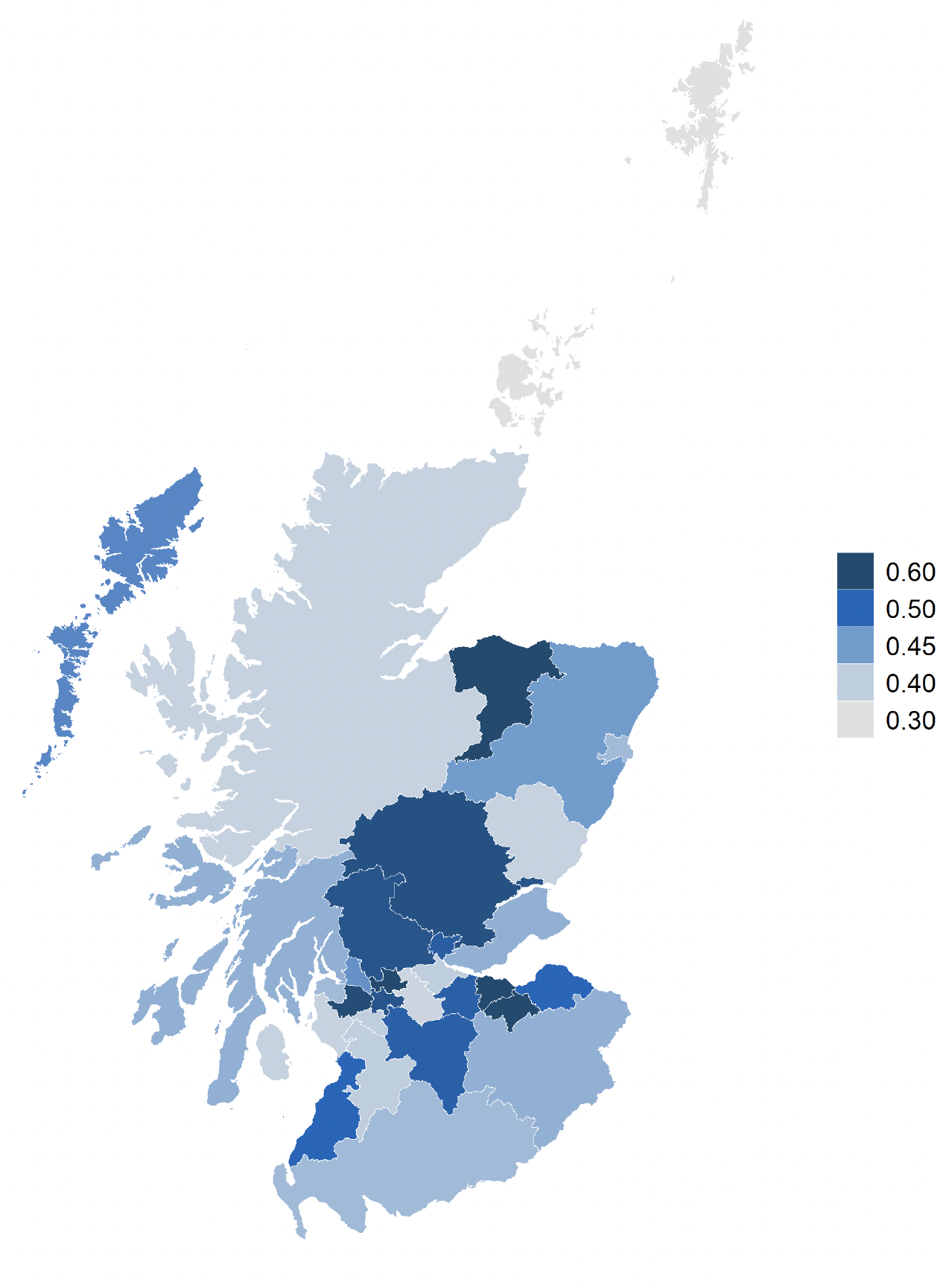 ELC places per child in formal group-based settings across Local Authorities in Scotland in 2021. The map focuses on places for 2-year-olds. The interval bands range from 0.30 to 0.60. The Local Authorities with the highest numbers are Midlothian, Moray, East Dunbartonshire, and City of Edinburgh (all above 0.6). Orkney Islands and Shetland Islands have the lowest numbers of ELC places for this age group (0.15 and 0.28 respectively). All the data in this heatmap is available in Appendix Table 1."/>
ELC places per child in formal group-based settings across Local Authorities in Scotland in 2021. The map focuses on places for 2-year-olds. The interval bands range from 0.30 to 0.60. The Local Authorities with the highest numbers are Midlothian, Moray, East Dunbartonshire, and City of Edinburgh (all above 0.6). Orkney Islands and Shetland Islands have the lowest numbers of ELC places for this age group (0.15 and 0.28 respectively). All the data in this heatmap is available in Appendix Table 1."/>
Source: Data provided by the Care Inspectorate (as of December 2021). Office of National Statistics Population Estimates for Scotland (2021)
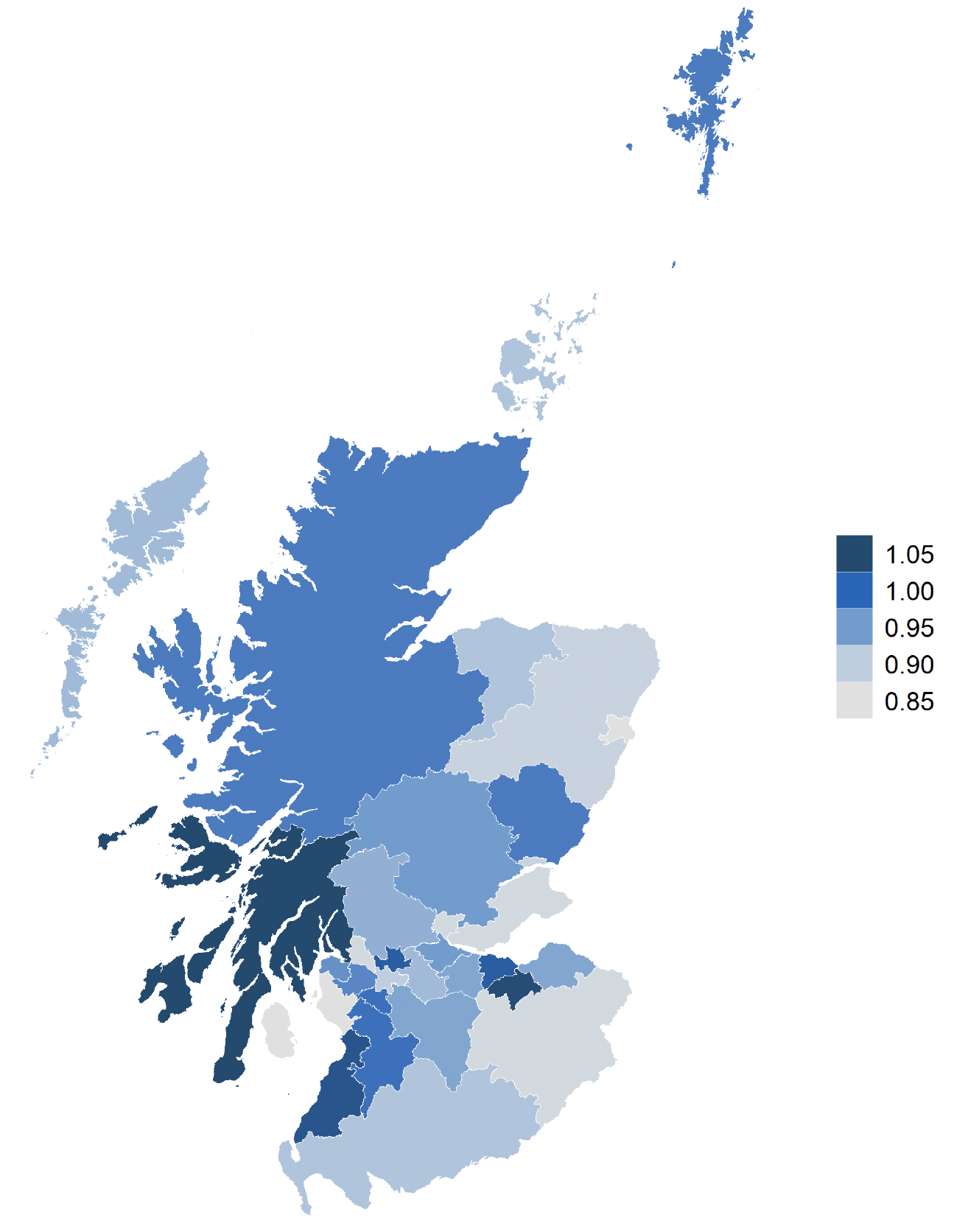 ELC places per child in formal group-based settings across Local Authorities in Scotland in 2021. The map focuses on places for 3- and 4-year-olds. The interval bands range from 0.85-1.05. The Local Authorities with the highest numbers are Argyll and Bute, South Ayrshire, and Midlothian. Aberdeen City and North Ayrshire have the lowest numbers of ELC places for this age group. Data on ELC places for 3- and 4-year-olds separately is available in Appendix Table 1."/>
ELC places per child in formal group-based settings across Local Authorities in Scotland in 2021. The map focuses on places for 3- and 4-year-olds. The interval bands range from 0.85-1.05. The Local Authorities with the highest numbers are Argyll and Bute, South Ayrshire, and Midlothian. Aberdeen City and North Ayrshire have the lowest numbers of ELC places for this age group. Data on ELC places for 3- and 4-year-olds separately is available in Appendix Table 1."/>
Source: Data provided by the Care Inspectorate (as of December 2021). Office of National Statistics Population Estimates for Scotland (2021)
While the maps above point to a relationship between rurality and remoteness and ELC places per child, a regression analysis can confirm this finding by establishing whether the relationship between rurality and availability of ELC places is persistent across the country, and whether this relationship still exists if we control for deprivation. Table 1 shows the results of such a regression analysis. The dependent variable in our regression is the number of ELC places per child (in formal group-based settings) and our independent variables include whether a region is an accessible rural area, a remote rural area, or an urban area, and the percentage of areas in each council that are deprived.[4]
The analysis showed that accessible rural areas have 0.14 fewer ELC places[5] per child, as compared to urban areas, while remote areas have 0.23 fewer places[6] than urban areas, even after controlling for deprivation. The regression also shows that increasing the share of deprived areas within a council by 1%, decreases the number of ELC places per child by 0.03. While this relationship is statistically significant, the magnitude is very small, indicating that rurality likely has a stronger correlation with ELC availability than deprivation.
It should be noted that the coefficients presented in Table 1 and discussed above only represent the correlation between rurality or deprivation of an area and the availability of ELC places, and do not imply a causal relationship. In other words, while it is true to say that rural areas and areas of higher deprivation have slightly lower number of ELC places per child, we cannot say that rurality or deprivation lead to lower ELC places per child. It may be that some other factor is causing these differences.
| Independent Variables | Coefficient | Std. Err | t | p>t | 95% | confidence interval |
|---|---|---|---|---|---|---|
| Accessible rural | -0.14 | 0.08 | -1.83 | 0.077 | -0.306 | 0.017 |
| Remote rural | -0.23 | 0.06 | -4.05 | 0.000 | -0.342 | -0.112 |
| Percent deprived areas | -0.003 | 0.0012 | -2.14 | 0.042 | -0.005 | -0.0001 |
| Constant | 0.483 | 0.0410 | 11.77 | 0.000 | 0.399 | 0.567 |
2.1.2 Number of service providers
The following table shows the number of ELC providers in Scotland, broken down by childcare type.
| Count of all ELC providers | Share offering places to 1-year-olds | Share offering places to 2-year-olds | |
|---|---|---|---|
| Childminders | 3,484 | Unknown | Unknown |
| Nurseries | 2,555 | 31.1% | 50.6% |
| Out of School Clubs | 711 | 0.3% | 0.6% |
| Playgroups | 132 | 1.5% | 81.8% |
| Children and Family Centres | 106 | 66.0% | 92.4% |
| Holiday Playschemes | 35 | 5.7% | 5.7% |
| Creches | 32 | 40.6% | 40.6% |
Source: Care Inspectorate Datastore (as of February 28, 2023) with matched additional data provided by the Care Inspectorate (as of December 2021)
The most common type of providers are childminders, followed by nurseries and out of school clubs. As there is no age disaggregated data on places within childminder settings, Table 2 does not show the share of childminders that offer places to 1- and 2-year-olds. Around half of all nurseries offer places to 2-year-olds, and just under a third have places for 1-year olds. A high number of children and family centres have places for both 1- and 2-year-olds. Interestingly, while just over 80% of playgroups have places for 2-year-olds, fewer than 2% offer places to 1-year olds. These shares are demonstrated in Figure 5.
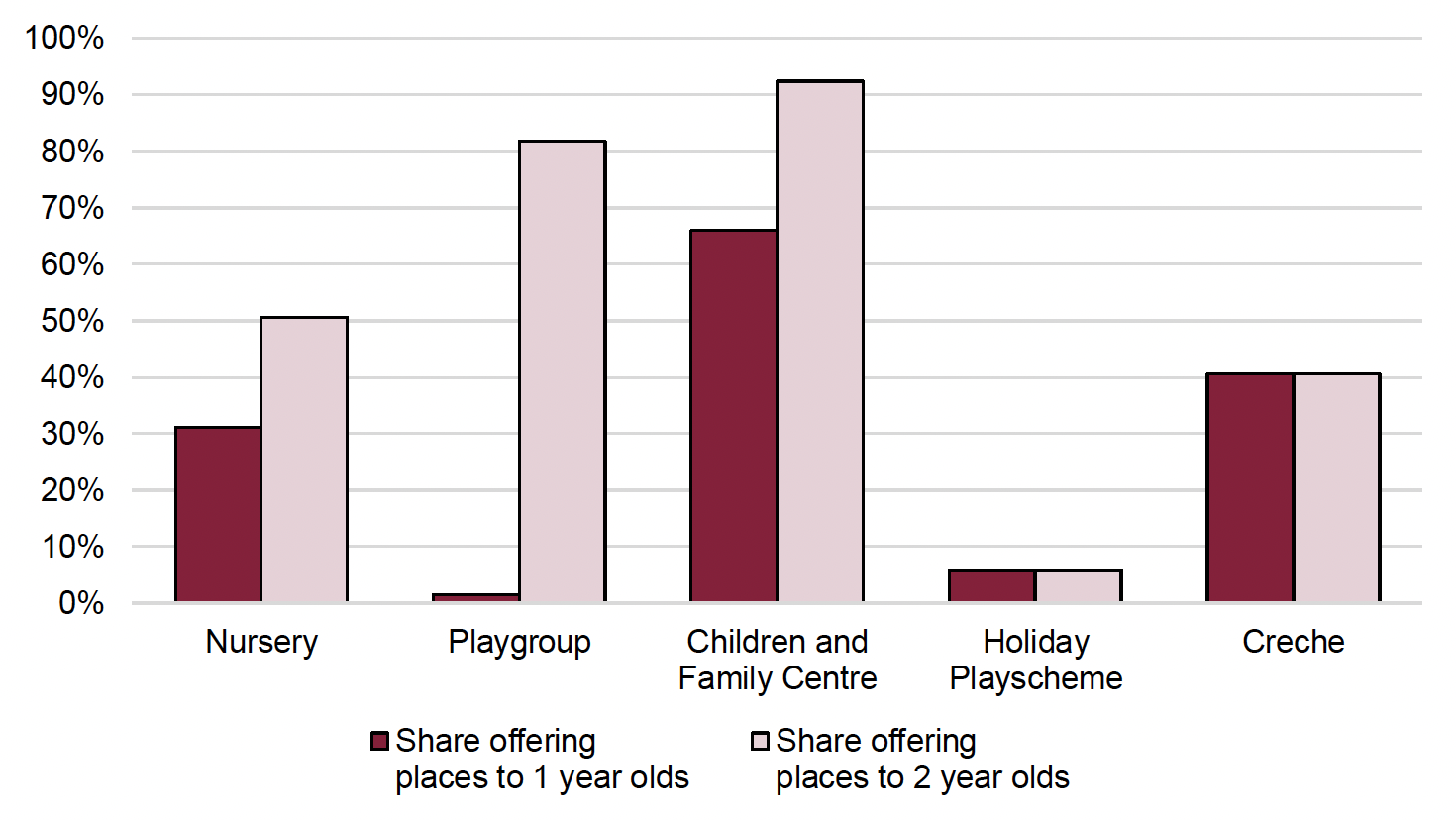 ELC providers offering places to 1- and 2-year-olds as of December 2021. 31% of nurseries, 1.5% of playgroups, 66% of children and family centres, 6% of holiday playschemes, and 41% of creches offer places to 1-year-olds. 51% of nurseries, 82% of playgroups, 92.5% of children and family centres, 6% of holiday playschemes, and 41% of creches offer places to 2-year-olds."/>
ELC providers offering places to 1- and 2-year-olds as of December 2021. 31% of nurseries, 1.5% of playgroups, 66% of children and family centres, 6% of holiday playschemes, and 41% of creches offer places to 1-year-olds. 51% of nurseries, 82% of playgroups, 92.5% of children and family centres, 6% of holiday playschemes, and 41% of creches offer places to 2-year-olds."/>
Source: Care Inspectorate Datastore (as of February 28, 2023) supplemented with additional data provided by the Care Inspectorate (as of December 2021)
Table 3 shows the count of formal group based ELC settings by provider type. ELC settings are most commonly run by LAs, followed by private sector providers, and then voluntary or not-for-profit run providers. Three ELC providers in the country are also run by Health Boards.
| Count | Share offering places to 1-year olds | Share offering places to 2-year-olds | |
|---|---|---|---|
| Local Authority | 1785 | 5.2% | 28.9% |
| Private | 1031 | 60.7% | 67.4% |
| Voluntary or Not-for-Profit | 686 | 19% | 37.3% |
Source: Care Inspectorate Datastore (as of February 28, 2023) supplemented with additional data provided by the Care Inspectorate (as of December 2021)
Apart from the variation across different ELC services, there is also variation in which types of providers offer places to 1- and 2-year-olds. While 67% of private providers have places for 2-year-olds, and 61% have places for 1-year-olds, only 28% of LA providers have places for 2-year-olds, and only 5% have places for 1-year olds. Thirty seven percent of voluntary or not-for-profit sector providers have places for 2-year-olds, and 19% have places for 1-year olds. This indicates that parents of younger children (and especially 1-year-olds) are much more reliant on private sector providers. It may be the case that a smaller share of LA providers offer places to 1- and 2-year-olds because they are focused on providing ELC to children included in the current funded offer. Private sector providers shown in Table 3 and in Figure 6 below do not include childminders, as the Care Inspectorate does not have age disaggregated data on places for these settings.
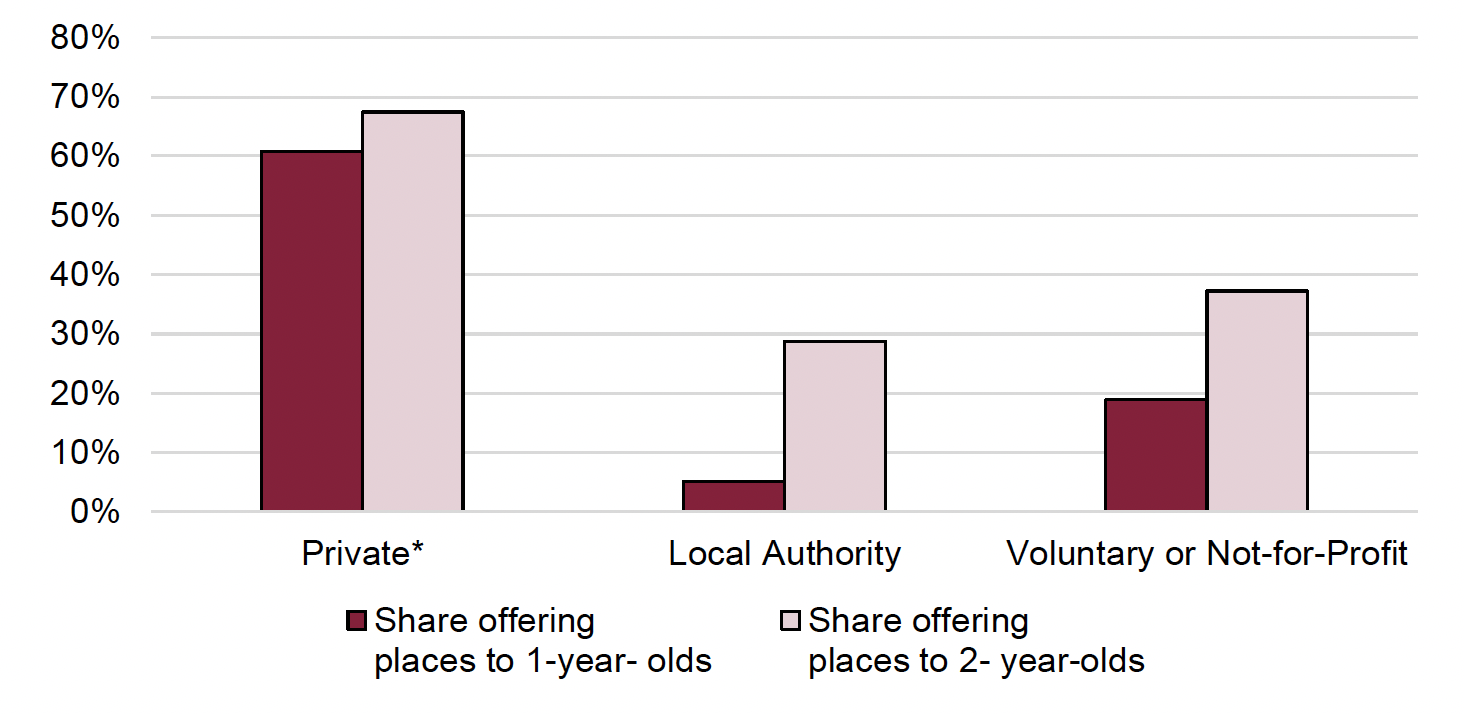 ELC providers offering places to 1- and 2-year-olds as of December 2021. 61% of private (excluding childminders), 5% of local authority, and 19% of voluntary or not-for-profit providers offer places to 1-year-olds. 67% of private (excluding childminders), 29% of local authority, and 37% of voluntary or not-for-profit providers offer places to 2-year-olds."/>
ELC providers offering places to 1- and 2-year-olds as of December 2021. 61% of private (excluding childminders), 5% of local authority, and 19% of voluntary or not-for-profit providers offer places to 1-year-olds. 67% of private (excluding childminders), 29% of local authority, and 37% of voluntary or not-for-profit providers offer places to 2-year-olds."/>
*Private sector providers exclude childminders.
Source: Care Inspectorate Datastore (as of February 28, 2023) supplemented with additional data provided by the Care Inspectorate (as of December 2021).
Regional Analysis
Figures 7 and 8 show the variation in formal group-based ELC provision across the five regions[7] in Scotland. The majority of providers are LA settings, with the Highlands and Islands and Southern Scotland having the highest proportion of LA providers, with 69%, and 57% respectively. This suggests that more rural regions may be more reliant on LA provision than urban regions, as it may more difficult for private providers to be financially sustainable in rural and remote areas. West Central Scotland has the lowest proportion of LA providers with 42% of all providers being run by LAs, and 40% of all providers being run by the private sector.
Figure 7: Share of providers by type and region (excluding childminders) as of 2023
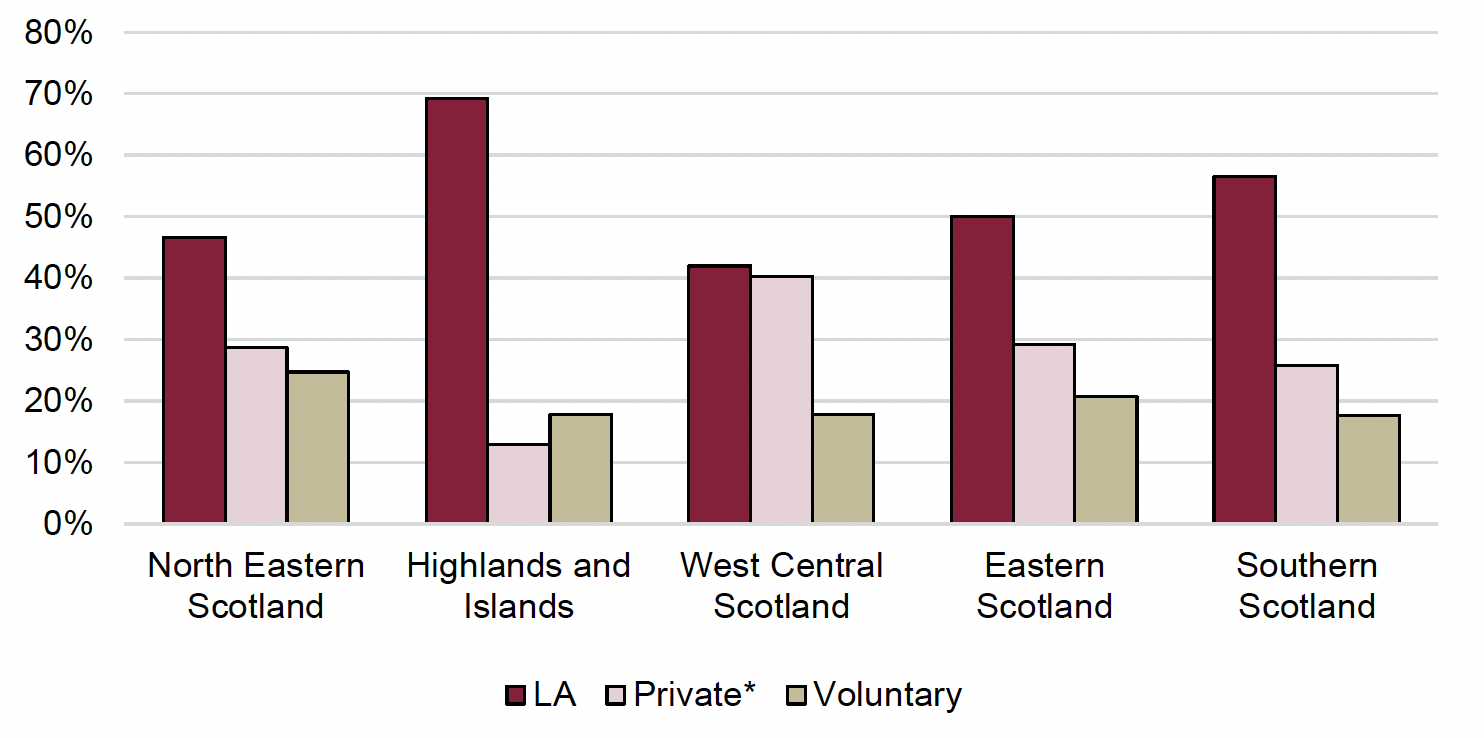
Source: Care Inspectorate Datastore (as of February 28, 2023). Scottish regions correspond to Office of National Statistics, ITL 2 regions (2021)
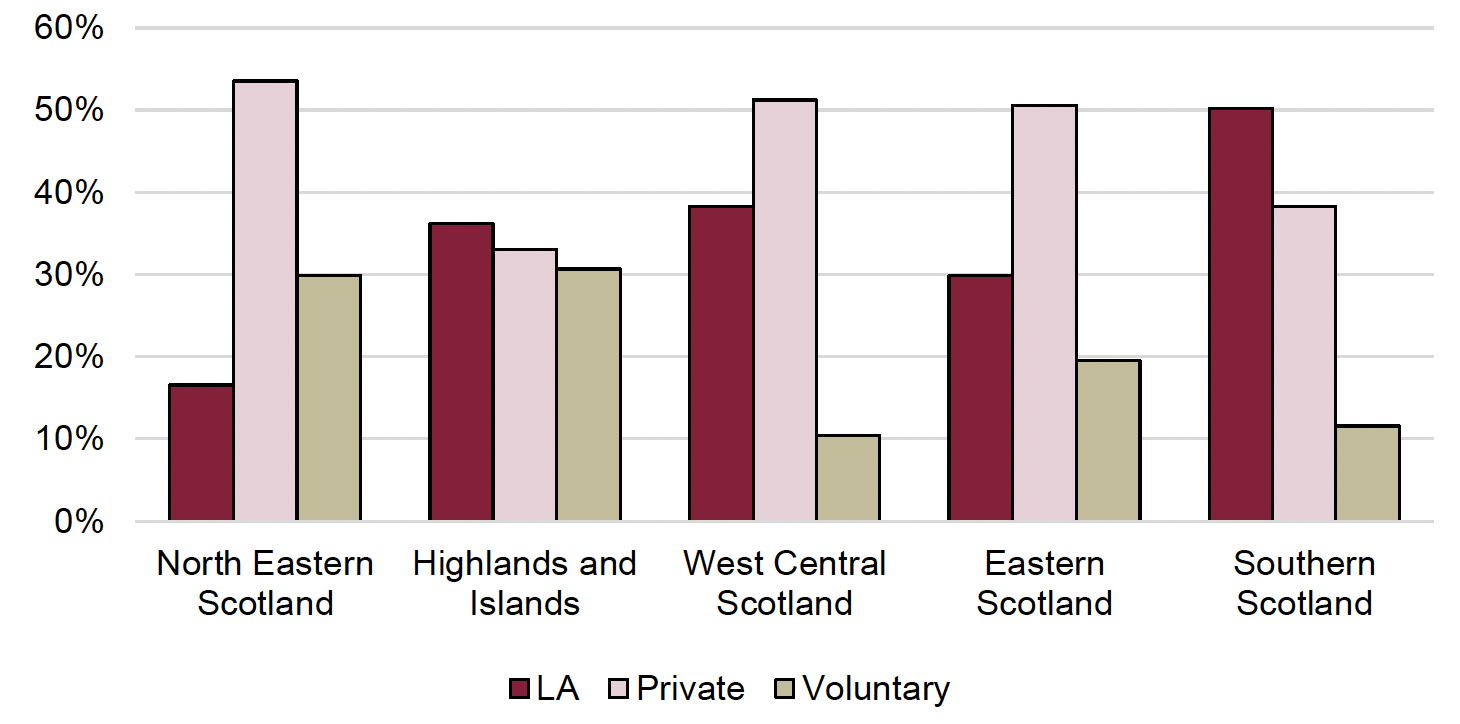
Source: Care Inspectorate Datastore (as of February 28, 2023), supplemented with additional data provided by the Care Inspectorate (as of December 2021)
In terms of providers who offer services to 1- and 2-year-olds, most regions have a higher share of private group-based providers and a lower share of group-based providers run by LAs. Only the Highlands and Islands and Southern Scotland regions have a higher share of LA group-based providers offering these services, with 36% of providers in the Highlands and Islands region offering services to 1- and 2-year-old children being run by LAs, and 33% being run by the private sector. In Southern Scotland, 50% of providers offering services to 1- and 2-year-olds are run by LAs, and 38% of providers are run by the private sector. In North-Eastern Scotland, West Central Scotland, and Eastern Scotland, over half of providers that offer services to 1- and 2-year-olds are run by the private sector.
2.1.3 Staffing
Number of registered children per registered staff member
The following tables compare the number of registered places in a setting to the number of full time equivalent (FTE) staff members. The number of registered places per FTE staff member varies by provider type, ELC type, and age group of the children being offered places. It is important to note that this is not a measure of child-to-staff ratio, and it is not an indication that any individual provider, or type of provider more broadly is not meeting Care Inspectorate requirements around child-to-staff ratios. Many children may only attend ELC for certain days of the week, use half-day provision, or only attend certain weeks of the year. Thus, not all children registered in a setting are present in the class simultaneously at any given time in the year. Instead, what this measure indicates is that settings with a higher number of registered places per FTE staff may rely on fewer staff to offer necessary provision and related tasks (e.g., administrative tasks).
This number also indicates which areas may have higher group sizes on average (although they do not show the actual class sizes for the reasons explained above). Additional research is required to understand the exact child-to-staff ratios and how staffing specifically will affect and be affected by the new offer for 1- and 2-year-olds.
Nationally, private nurseries that provide places for 1- and 2-year-olds have a lower number of registered places per FTE than nurseries run by LAs or the voluntary sector. Private nurseries have 5.9 registered places per FTE staff member per setting on average, while LA nurseries and voluntary sector nurseries have 9.8 and 9.9 registered places per FTE staff member respectively. Within the private and voluntary sectors, other types of providers (creches, children and family centres, and playgroups) have higher numbers of registered places per FTE than nurseries. This may be driven by these types of providers offering more ad-hoc care, which children may only attend for limited hours of the day, or limited weeks of the year. However, of providers run by the LAs, nurseries have a higher number of registered places per FTE staff member than other types of providers. In general, there is a lower number of registered places per FTE staff member in providers with places for 1- and 2-year-olds compared to all providers, due to regulatory differences set by the Care Inspectorate[8].
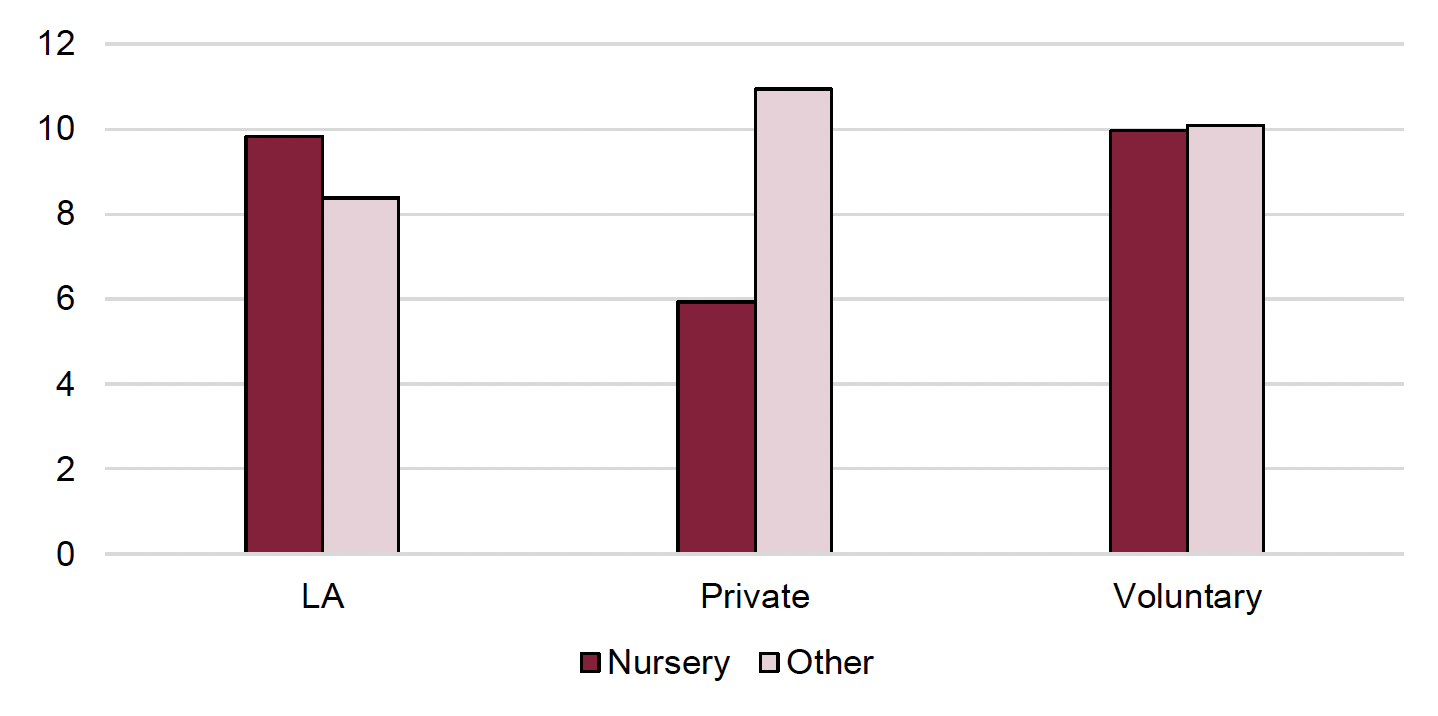 LA settings is around 10 for nurseries and 8 for other types of provision. For voluntary providers, both numbers are around 10. Regarding private providers, nurseries have 6 places per whole time equivalent staff members, and other types of provision around 11."/>
LA settings is around 10 for nurseries and 8 for other types of provision. For voluntary providers, both numbers are around 10. Regarding private providers, nurseries have 6 places per whole time equivalent staff members, and other types of provision around 11."/>
Source: Care Inspectorate Datastore (as of February 28, 2023) supplemented with additional data provided by the Care Inspectorate (as of December 2021)
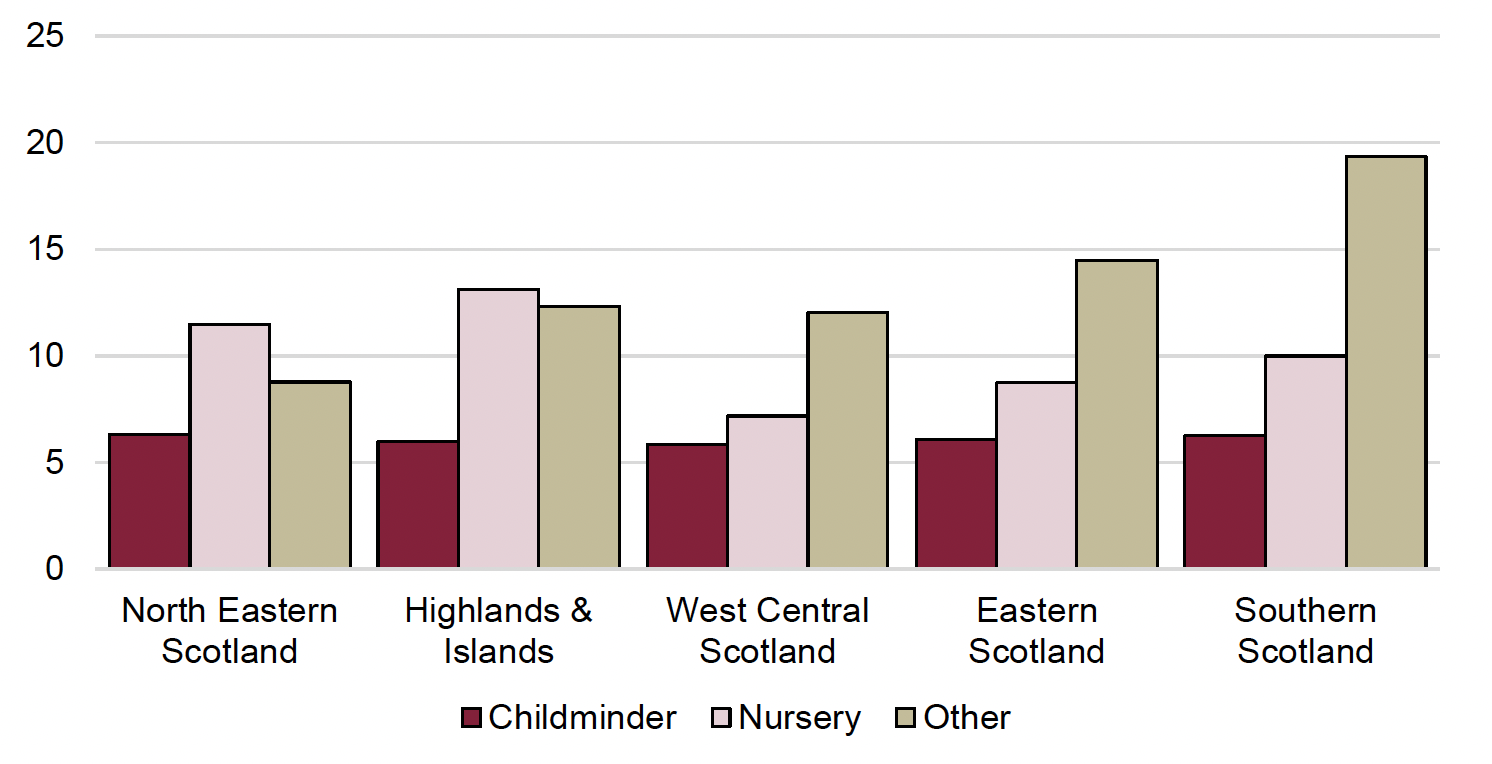 WTE staff member across different regions and types of provision. For childminders, the number is around 5 across all regions. For nurseries, the number varies from 7 (West Central Scotland) to 13 (Highlands and Islands). For other types of provision, the number varies from 19 in Southern Scotland to 9 in North Eastern Scotland."/>
WTE staff member across different regions and types of provision. For childminders, the number is around 5 across all regions. For nurseries, the number varies from 7 (West Central Scotland) to 13 (Highlands and Islands). For other types of provision, the number varies from 19 in Southern Scotland to 9 in North Eastern Scotland."/>
Source: Care Inspectorate Datastore (as of February 28, 2023). Regions correspond to Office of National Statistics ITL 2 Territories.
Figure 10 shows the variation in number of registered places per FTE staff member by region and type of provision across all providers. Across all regions, registered places per FTE staff member within childminder settings is relatively stable, at between 5.8-6.3 children per staff member. However, there is much more variation across regions for nurseries, ranging from 7.19 in West Central Scotland to 13.1 in the Highlands and Islands. Other providers (children and family centres, creches, playgroups, and out of school clubs) seem to have a higher number of registered places per FTE staff member than both childminders or nurseries.
As shown in Figure 11, across providers who offer services for 1- and 2-year-olds, the number of registered places per FTE staff member in nurseries ranges from 5.93 places per staff member in West Central Scotland to 10.4 places per staff member in the Highlands and Islands. For all types of providers with places for 1- and 2-year-olds, the Highlands and Islands and Southern Scotland have the highest number of registered places per FTE staff member. On the other hand, West Central Scotland and Eastern Scotland (where Glasgow City and the City of Edinburgh respectively are located) have the lowest number of registered places per FTE staff. This indicates that staffing shortages may be more severe in rural and remote areas.
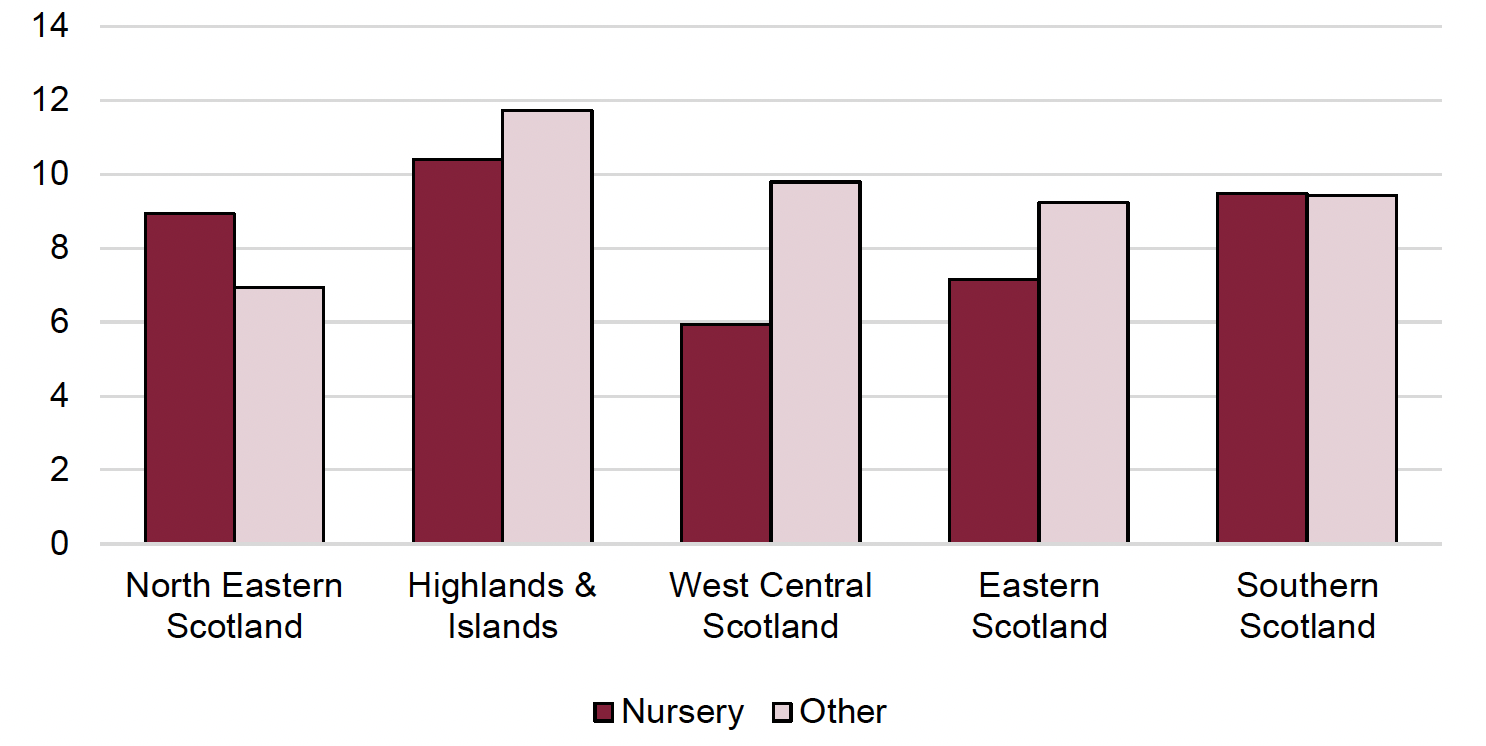 WTE staff member across different regions and types of provision for providers offering services to 1- and 2-year-olds (excluding childminders). For nurseries, the number varies from 6 (West Central Scotland) to 10 (Highlands and Islands). For North Eastern and Southern Scotland is around 9, and for Eastern Scotland the number is around 7. For other types of provision, the number varies from 7 in North Eastern Scotland to 12 in Highlands and Islands. The number for all other regions is between 9.2 and 9.8."/>
WTE staff member across different regions and types of provision for providers offering services to 1- and 2-year-olds (excluding childminders). For nurseries, the number varies from 6 (West Central Scotland) to 10 (Highlands and Islands). For North Eastern and Southern Scotland is around 9, and for Eastern Scotland the number is around 7. For other types of provision, the number varies from 7 in North Eastern Scotland to 12 in Highlands and Islands. The number for all other regions is between 9.2 and 9.8."/>
Source: Care Inspectorate Datastore (as of February 28, 2023). Regions correspond to Office of National Statistics ITL 2 Territories.
2.1.4 Analysis by urban rural disaggregation
This section discusses the variation in ELC provision across areas with different degrees of rurality. As the data presented in Figures 12 and 13 are not disaggregated by age group, childminders are included in the analysis.
To categorise areas by rurality, the Scottish Government's urban rural disaggregation, which divides all areas in Scotland into urban, accessible rural, or remote rural areas was used[9].
In general, consistent with our regional analysis, remote rural areas are more reliant on LA run providers than urban areas and accessible rural areas, with 52.7% of all providers in remote areas being run by LAs compared to 29.4% of providers in accessible rural areas and 22.5% in urban areas. This is consistent with information in the policy literature[10] and testimony provided by stakeholders supporting the view that it is more challenging for private providers to operate in remote rural areas. In urban areas and accessible rural areas, the majority of ELC providers are run by the private sector, with 67.3% of all providers in urban areas and 62.6% of all providers in accessible rural areas being run privately. Voluntary sector provision is slightly more common in urban areas compared to rural areas, with 10% of providers in urban areas run by the voluntary sector, compared to 8.1% in accessible rural areas, and 8% in remote rural areas.
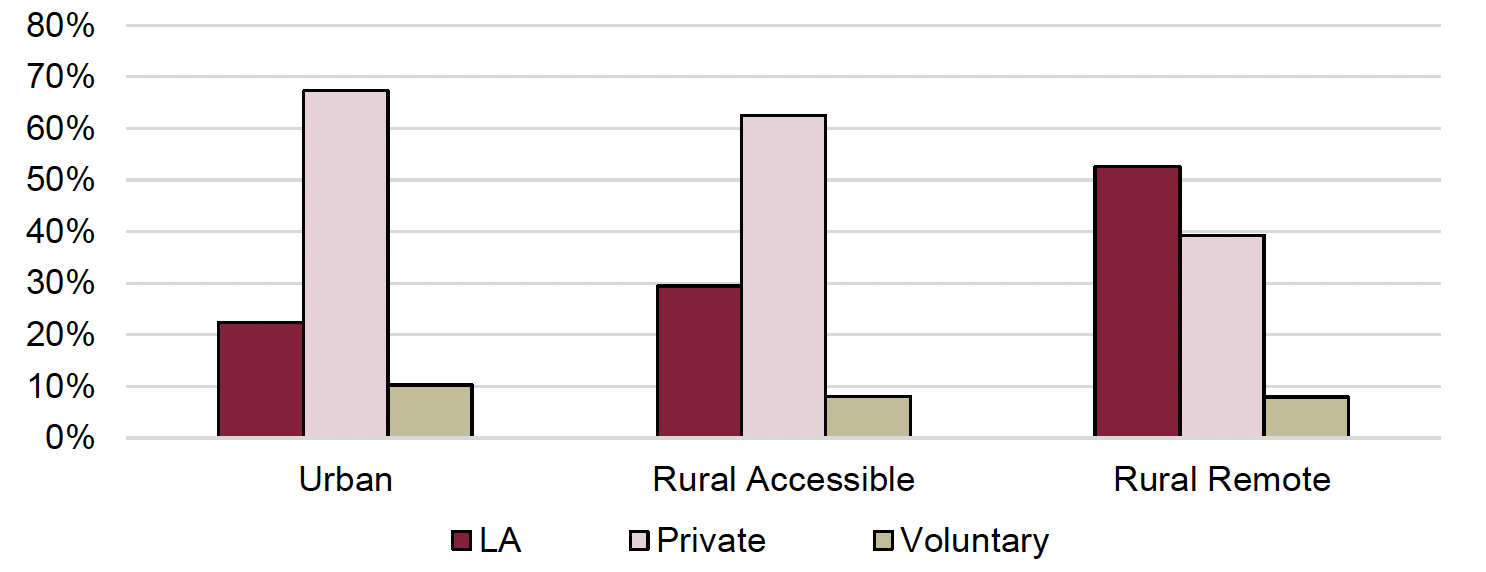 LA (22.5% for urban areas and 29% in rural accessible areas) and voluntary provision (10% in urban areas and 8% in rural accessible). In remote rural areas, 53% of provision is provided by LA-run settings, 39% by private settings, and 8% by the voluntary sector."/>
LA (22.5% for urban areas and 29% in rural accessible areas) and voluntary provision (10% in urban areas and 8% in rural accessible). In remote rural areas, 53% of provision is provided by LA-run settings, 39% by private settings, and 8% by the voluntary sector."/>
Source: Care Inspectorate Datastore (as of February 28, 2023). Scottish Government Urban Rural Classifications (2020).
Regarding ELC types, remote rural regions are much more reliant on nurseries, which make up 59% of all provision in those areas, compared to 37% in accessible rural areas, and 34% in urban areas. In accessible rural areas and urban areas, childminders make up just over half of all provision, accounting for 51% in urban areas and 53% in accessible rural areas, compared to only 35% in remote rural areas. It could be that it is more challenging for childminders to operate sustainably in remote areas than other types of providers. Other types of ELC (children and family centres, playgroups, creches, and out of school clubs) are also more widely available in urban areas. This indicates that parents and carers in urban areas may have more choices across ELC types than in rural areas, with the lack of choice being much more pronounced in remote rural areas.
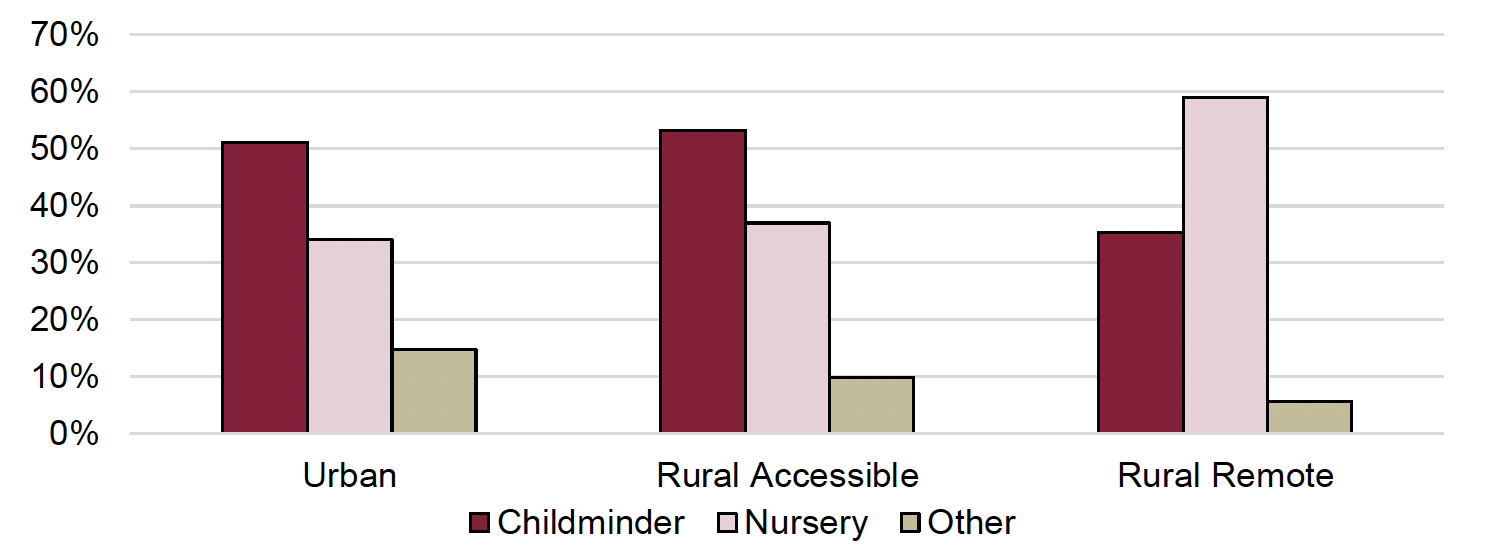
Source: Care Inspectorate Datastore (as of February 28, 2023). Scottish Government Urban Rural Classifications (2020).
2.2 Stakeholder engagement
2.2.1 Focus group and interviews
As descibed in Section 1.3, the engagement with key stakeholders was aimed at gaining a broad overview and understanding of ELC provision across Scotland. This section outlines the key considerations raised by stakeholders.
Current ELC provision for 1- and 2-year-olds
The primary challenge discussed by stakeholders related to the accessibility and availability of ELC provision for this younger age group. Stakeholders noted that there are fewer providers that offer services for 1- and 2-year-olds. One reason for this is that different spaces and facilities are suitable for children of different age groups, e.g., younger children require different toilet facilities. Having fewer providers offering services can also lead to long waiting lists to access services and families being limited in their choice of ELC provision for their children. This barrier may be further pronounced in rural and island communities where families may be required to travel long distances to access services. An additional challenge in rural and island communities is that it can be difficult to find Gaelic-speaking staff for families that seek Gaelic-run provision.
An additional point raised is that younger children benefit from attachment-led models and that a focus on family learning and engaging with parents is highly important. This can include models such as 'Stay-and-Play', where parents can stay with their children in the ELC settings and engage in activities together. Furthermore, childminders were considered to be key to providing ELC for 1- and 2-year-olds because their settings mimic the nurturing home environment that children of this age are used to.
Stakeholders were also asked for their views on ELC provision for children with additional support needs (ASN). In terms of challenges, it was mentioned that it can be difficult for some families and providers to access the related services (e.g., health and social care) that they need to be able to support children with ASN effectively. A further challenge relates to children of this age group being less likely to have received a clear diagnosis. It could therefore be that staff will need additional training to recognise early signs and symptoms of ASN among 1- and 2-year-olds.
Keeping these challenges in mind, stakeholders emphasised that it would be beneficial if a new offer is not considered in isolation but packaged with other services that children with ASN access. It was also mentioned that providers need to be funded appropriately to enable them to deliver high-quality ELC for these children, particularly if staff require additional training or need to be able to provide one-to-one support for children that need it.
A new funded ELC offer for 1- and 2-year-olds
While this report does not constitute a formal consulation on the new offer of ELC for 1- and 2-year-olds, as part of the discussion on the current provision the stakeholders also discussed challenges and opportunities of the new offer, which are presented below.
Firstly, according to stakeholders, ELC provision should be designed to meet the needs of 1- and 2-year-olds, who often require more hands-on support than older children. To ensure that younger children are not overwhelmed, this means it is important that: (i) each staff member does not support too many children at once, (ii) the number of children in each group is not too high, and (iii) the physical space that children are in is not too large.
Secondly, there must be sufficient capacity in the workforce to meet the demand for ELC, which will increase when the new offer is introduced, and staff need to be supported. This can be achieved by training staff and tailoring workforce learning and development pathways to reflect the skills required to meet the needs of 1- and 2-year-olds and their families, such as through professional placements working with children of different ages. This was described as particularly important because there is currently a smaller pool of staff that have experience working with this younger age group. Importantly, it was highlighted that the necessary training should take place before the offer is introduced.
A further way of achieving sufficient capacity within the workforce is by utilising all types of providers that are willing to be included within the offer. For instance, the childminding workforce as well as providers that are currently unregulated may be key to ensuring that all eligible children can access a service. This may further mean a move away from what stakeholders described as the norm for families, i.e., that a child should go to an LA nursery. Furthermore, actions can be taken to improve the social standing of the profession to ensure that people want to join and stay in the sector.
Thirdly, according to stakeholders, to ensure that families are supported, and to reflect that their needs will vary, the new offer should allow them to choose from different provision types. Parents may further benefit from parental engagement and family learning activities, which can help them feel more confident and comfortable in their parenting abilities as well as in introducing their children to ELC at such a young age. As such, it is important that facilities have the space to accommodate families as well.
Lastly, it was mentioned that increased funding, as well as higher salary rates, will be needed for all providers to be able to provide 1- and 2-year-olds with high quality ELC provision.
Takeaways from the current funded ELC offer
While discussing provision for 1- and 2-year-olds, stakeholders also brought up challenges and opportunities associated with the current funded ELC offer. Many stakeholders' views on the new offer of ELC for 1- and 2-year-olds are shaped by their experiences of the current funded offer of 1140 hours for 3- and 4-year-olds and eligible 2-year-olds. Some of the lessons learned from the current ELC offer may help to inform certain elements of the new offer for 1- and 2-year-olds.
There was a consensus among stakeholders that a primary challenge for all providers is the recruitment and retention of staff. Stakeholders explained that this could be, in part, because staff feel that they are not being compensated fairly for their work. While a concern about pay was described in relation to both sectors, it was mentioned that private, voluntary and independent (PVI) providers are losing staff to LA settings, which may pay higher wages and offer better benefits for staff. Recruiting and retaining staff may be particularly difficult in rural and island communities, where it is common that a small population is spread across a large geographic area. Moreover, it was described that the need for training and attaining a qualification may pose a barrier for people to enter the profession as there are often other sectors (e.g., hospitality) in rural and island communities that do not have such a requirement.
A further challenge raised by stakeholders concerned the eligibility criteria for the 2-year-olds that can access ELC within the current offer. Stakeholders felt that more clarity around eligibility criteria is needed, which may have contributed to the policy being inconsistently implemented across Scotland. It was also mentioned that unclear criteria may also have led to some parents not being aware of their children's entitlement to access services. In addition, stakeholders described how families may not be able to make an informed choice regarding the type of ELC provision for their child, because it is the norm to attend LA nurseries. As such, some families may not be aware that there are other options available.
The availability of ELC services in different areas in the country was also a challenge mentioned by stakeholders that is particularly pronounced in rural and island communities. Furthermore, the demand for ELC services may vary significantly across the year in rural and island communities dependent on the hospitality and tourism sectors. The variation in demand for services across different time periods in the year makes it not only difficult to track demand but also to provide services in these areas.
When discussing examples of good practice, stakeholders emphasised that the quality of ELC provided for 3- and 4-year-olds and eligible 2-year-olds under the current offer was high. Scotland's 'Getting It Right For Every Child' policy was mentioned as something that works well, and it was highlighted that all families' and children's needs are different, which ELC provision needs to reflect. In addition to this, the findings from a recent survey that looked at parents' views and experiences of ELC were discussed. Overall, the survey found that parents have a positive view of the funded offer and appreciate both the quality and flexibility of provision that it offers.[11]
2.2.2 Survey of Local Authorities
As the final research activity in Phase 1, LAs in Scotland were surveyed on ELC provision for 1- and 2-year-olds in their area, examples of innovative provision in their areas, and considerations related to the new offer for 1- and 2-year-olds. This section summarises the findings from the survey. Additional figures showing the responses from all questions are available in Appendix 1.
Current provision for 1- and 2-year-olds
The most common provider type for 1- and 2-year-olds were childminders and nurseries, with all LAs who answered the survey (26) having provision available for 1- and 2-year-olds in these types of settings. The next most common type was playgroups, with 16 LAs responding they have playgroups for 1- and 2-year-olds. Eight LAs responded that they have children and family centres for 1- and 2-year-olds, and six have creches.
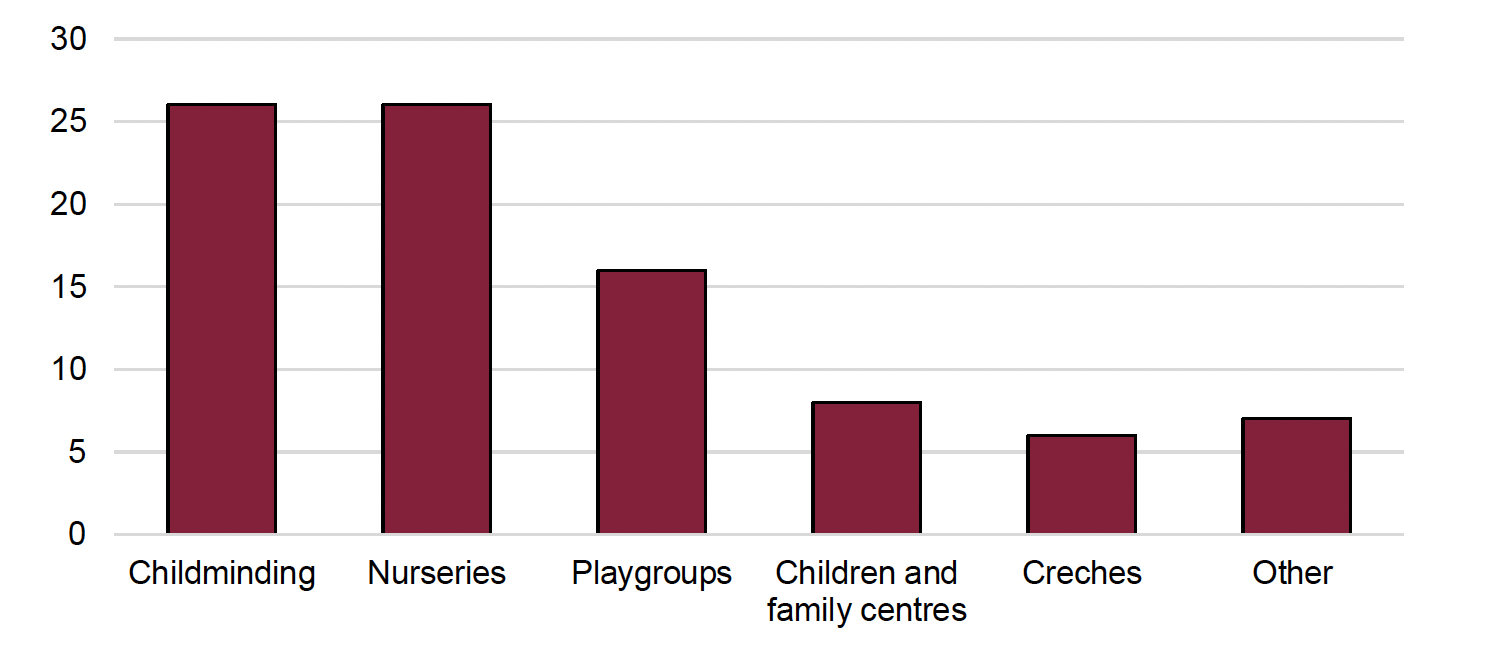 LA representatives' responses to what provision is available in their area. All respondents (26) reported having childminding settings and nurseries in their areas, 8 LAs reported playgroups, 8 children and family centres, 6 creches and 7 mentioned other types of provision."/>
LA representatives' responses to what provision is available in their area. All respondents (26) reported having childminding settings and nurseries in their areas, 8 LAs reported playgroups, 8 children and family centres, 6 creches and 7 mentioned other types of provision."/>
In addition to the types listed above, some respondents outlined further types of ELC available for 1- and 2-year-olds in their LA, including parent and toddler groups (e.g., Stay and Play), family support programmes (e.g., Parents as Early Education Partners and Psychology of Parenting) and community childminding.
In many LAs, ELC provision may be offered through programmes or organisations that are not formally classed as ELC, as they offer a wider range of services to children and families. These programmes could offer examples of innovative service delivery for 1- and 2-year-olds. The majority of LAs (15) responded that they are aware of additional types of ELC, however 7 responded that they do not have additional types, and five did not know about any additional types. The most frequently[12] mentioned alternative programmes include:
- Parents as Early Education Partners (PEEP)
- Home Start
- Parent and toddler groups (informal sessions where parents spend time with their children in the company of others, usually engaging in an activity)
- Baby Massage (programmes teaching parents to give their babies massage)
- Community childminding
- Incredible Years
- Playgroups (regular short sessions of care and learning through play for children not old enough to go to school).
- Family support services (provide a wide range of services to support families, including signposting and referrals to other services).
- Stay Play & Learn
Gaps in current provision for 1- and 2-year-olds
LAs were asked about specific gaps in current ELC provision for 1- and 2-year-olds. While the current funded offer does not include all 1-and 2-year olds, their responses shed light on existing gaps in ELC provision and capacity for 1-and 2-year olds.
Despite being the most common provision types, the majority of LAs responded that there is currently not enough provision for 1- and 2-year-olds within both childminder and nursery settings. Eighteen LAs acknowledged there are not enough places in childminder settings, and 19 responded there were not enough places in nurseries. Despite being available in all responding LAs, the survey results indicate that some families currently may not be able to access provision in nurseries and through childminders, even if there is a setting in their area. Other providers that were commonly listed as currently not having enough places were children and family centres (14 responses), creches (11 responses), and playgroups (10 responses). Only two LAs answered that they have no gaps in provision for 1- and 2-year-olds.
LAs also responded that currently existing gaps are different across age groups, with 19 responding LAs stating that there were gaps in ELC provision for younger children, but not for older children. Five LAs answered that there are gaps for both age groups, but the gaps are different. Only one LA responded that there were no gaps in provision for either age group. No LAs answered that there are no gaps for younger children, but there are gaps for older children; or that the gaps are the same for both age groups. This indicates that in most LAs, provision for 1- and 2-year-olds is currently less readily available, as compared to provision for 3- and 4-year-olds.
Challenges in providing ELC to 1- and 2-year-olds
LAs were asked in a free-text question about the main challenges associated with providing ELC to 1- and 2-year-olds, and if this contributed to gaps.
Lack of capacity to meet demand
Overall, many of the challenges raised by LAs related to the overarching concern that there would not be sufficient capacity to meet the increased demand for ELC provision that a new offer would bring. This includes capacity in relation to having the necessary providers, places, infrastructure, as well as workforce in place to effectively deliver the offer. The concerns regarding each of these factors are provided in more detail below.
Providers and places
One of the main challenges highlighted by survey respondents was that there will be an insufficient number of ELC providers, and available places for children, to cope with the increased number of 1- and 2-year-olds that will require services when the new funded offer is rolled out. Furthermore, it was described that this availability will vary both between LAs as well as within them. For instance, a gap in services may be more likely in rural regions as provision is often concentrated in areas of higher population.
Some respondents suggested that the lack of ELC providers and places is, in part, due to a large amount of capacity having been used to deliver the current funded offer. Furthermore, the high cost of delivering services for 1- and 2-year-olds, and the limited statutory funding that has been available for this age group, has meant that the existing provision is less extensive across Scotland.
Infrastructure
In addition to the availability of providers and places, respondents also expressed concern about having the infrastructure and facilities necessary to provide services for 1- and 2-year-olds. Some respondents mentioned that existing facilities have been utilised to deliver the current funded offer, limiting the possibility for expansion. A further barrier mentioned is that, with existing facilities, it may be difficult for providers to meet the specific Care Inspectorate requirements for this younger age group (e.g., 1:3 adult to child ratio[13], there should be a minimum of one nappy changing facility per 10 children using nappies[14]).Overall, it was emphasised that many areas will need to acquire or build additional facilities and/or adapt available spaces to be suitable for younger children to deliver the new funded offer.
Workforce
A further capacity-related challenge mentioned by LAs was that the existing workforce will not be sufficient to support the rollout of a new funded offer. Respondents stated that there are currently difficulties recruiting and retaining staff, and this will remain a significant challenge going forward. It was also noted that the higher adult-child ratios required for younger children will mean that more staff will need to be employed by settings than previously.
Moreover, respondents expressed concern that the workforce may not have the skills and training required to provide high quality care for 1- and 2-year-olds. Respondents highlighted that, since these younger children have different needs compared to older children, and there is less experience working with this age group within the workforce, existing staff may not be as well-equipped to care for them.
Geographical challenges
Several barriers to providing ELC for 1- and 2-year-olds were mentioned by respondents that related to the geographical characteristics of their LA. Some respondents discussed how many of the challenges in providing services for 1- and 2-year-olds (e.g., recruiting and retaining staff) may be greater in rural communities. Furthermore, it may not be financially sustainable for providers to operate in rural communities, particularly in areas where there are very few children needing to access ELC. Additionally, the need to travel long distances and a lack of transport links can make accessing services challenging for both staff and families in many areas.
Funding and cost of delivering services
Respondents also highlighted several challenges related to the cost of providing ELC for 1- and 2-year-olds. It was mentioned that it is more costly to deliver services for this younger age group, compared to older age groups. One reason for this is that 1- and 2-year-olds require higher adult-child ratios than 3- to 5-year-olds. As such, some respondents suggested that to be able to deliver the new offer effectively, providers need both sufficient funding and support from the Scottish Government.
Additional challenges
While the challenges that were most frequently mentioned by survey respondents have been outlined in detail above, the following are examples of additional points raised by a smaller number of respondents:
- ELC provision may not be appropriate or beneficial for 1- and 2-year-olds.
- The eligibility criteria for children for a new offer is unclear.
- It is too early to learn lessons from the current offer.
- Children with ASN may find extended hours in ELC difficult to manage.
Reluctance to provide ELC services to younger children
When asked if providers are more reluctant to provide ELC services to younger than older children, 12 LAs responded that some providers are more reluctant to provide ELC to 1- and 2-year-olds, as compared to 3- and 4-year-olds, and 10 answered that they did not know if providers are more reluctant to offer ELC to 1- and 2-year-olds. Only four LAs answered that providers in their areas are not more reluctant to offer ELC to 1- and 2-year-olds, indicating that the challenges described above may be significant enough that some providers would prefer to opt out of care for this age group.
The most common responses from LAs around why providers were more reluctant to offer places to 1- and 2-year-olds were that: 1- and 2-year-olds require more attention, and therefore providers must hire additional staff (11 responses), that there were other additional costs associated with offering places to younger children (11 responses), and that providers need to alter their physical environments in order to provide places to younger children (10 responses). Other answers include that it was difficult to offer provision to both 3- and 4-year-olds and 1- and 2-year-olds based on differing needs (7 responses) and that staff required additional qualifications, or there were additional safeguarding regulations associated with work with this age group (4 responses). Most LAs provided multiple reasons as to why providers were more reluctant to offer ELC to 1- and 2-year-olds.
Alt The figure shows the LA responses to the question "Why are providers more reluctant to provide ELC to younger children?". The options "they require more attention and therefore more staff" and "other additional costs" receive 11 responses. 10 respondents chose "needing to alter physical environment", 7 respondents chose "difficult to offer provision to both age groups", and 4 respondents chose "staff require additional qualifications" and "additional safeguarding concerns".
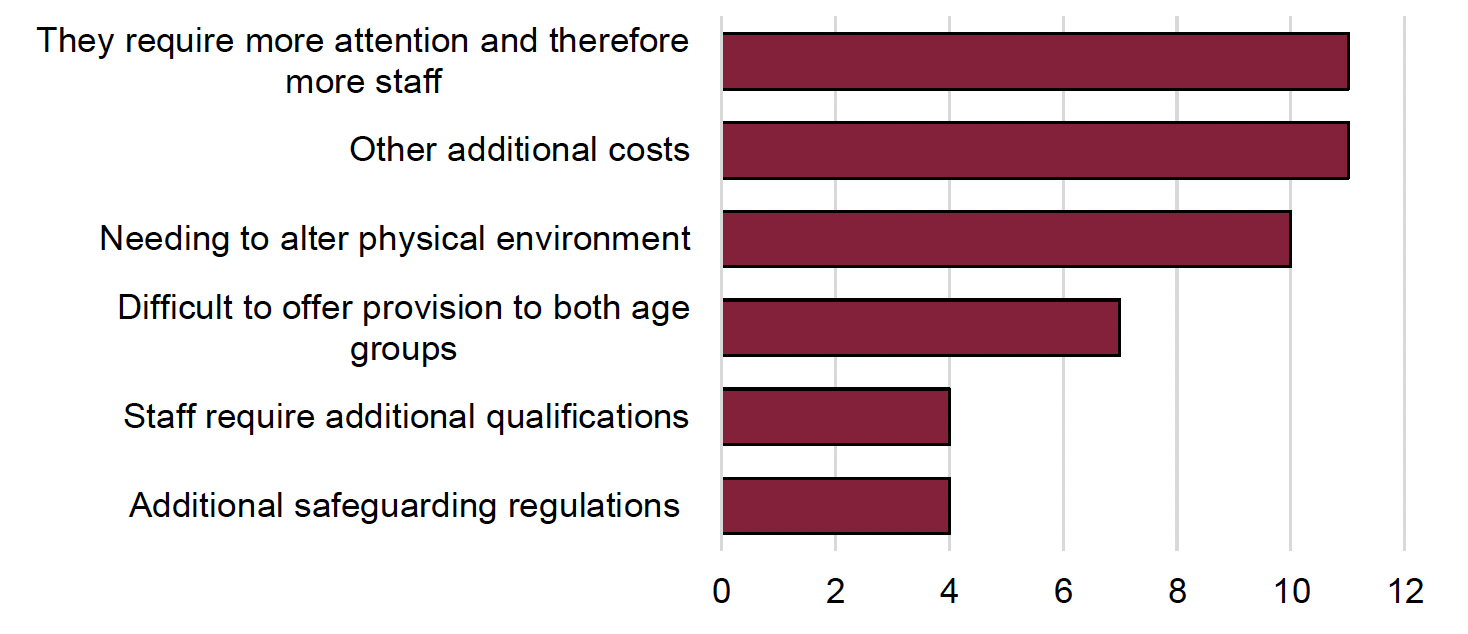
Concerns with a new offer
LAs were also asked about their concerns with an expansion of the funded offer to 1- and 2-year-olds. Many of the answers regarding concerns with a new offer overlapped with reasons why providers may be reluctant to offer places to 1-and 2-year-olds. All 26 responding LAs reported being concerned about a lack of capacity within existing providers to accommodate increased demand, and difficulties around recruiting new staff with appropriate qualifications. Many LAs are also concerned that it will be difficult for providers to offer the wider range of services potentially included in the new offer (24 responses). No LA responded that they were unsure of or unaware of any concerns, and all respondents listed more than one concern.
Five respondents outlined additional concerns with the expansion of the funded offer to all 1- and 2-year-olds, including:
- Due to the limited provision of ELC for 1- and 2-year-olds currently, it is difficult for students to gain experience with this younger age group.
- Facilities not being suitable for 1- and 2-year-olds.
- The high cost of providing high quality ELC for 1- and 2-year-olds.
- The need for appropriate funding to deliver the offer.
- The quality of provision will be affected by having a wider age range within settings.
- Younger children will find the hours in ELC settings difficult to manage.
Additional Support Needs
Most (20) LAs are aware of ELC programmes serving children 0-4 with additional support needs (ASN) in their LA. However, 6 LAs are not aware of any such programmes.
The ASN programmes most commonly listed by LAs are:
- speech and language therapy and family play and parenting (15 responses)
- bilingual or sign language translation programmes (8 responses),
- at-home ELC programmes (4 responses)
Five LAs that responded to the survey did not provide a response to this question. In addition to the types listed above, 11 respondents outlined further programmes available to pre-school children with ASN. These included: developmental nurseries, multi-agency drop-in groups, specialist family centres, specialist ELC provision (including nurseries), provision within mainstream services, and Enhanced Learning Outreach services.
Out of the 21 LAs that gave examples of ASN programmes, only 7 answered that the programmes listed are available for 1- and 2-year-olds, while 6 stated they are not available for this age group. 7 LAs responded that some of the programmes offer places to 1- and 2-year-olds while some don't, and 3 did not know if programmes have places for 1- and 2-year-olds or not. ASN programmes available to 1- and 2-year-olds listed by LAs include: developmental and specialist nurseries, family play and parenting programmes, speech and language therapy programmes, sensory play programmes, at-home parent and toddler groups, Early Years Services, nurture groups, PEEP, Incredible Years (IY), and 5 to Thrive.
Most LAs responded that ELC for children with ASN is most commonly provided alongside children without ASN in mainstream settings. Some LAs responded that both specialised providers and provision alongside children without ASN was common. In most LAs (19), provision for children with ASN was provided by the LA. Only one LA answered that most provision for children with ASN was provided by private providers.
Tracking demand
Nineteen LAs said they track demand for ELC by age group, and 14 track demand by type of provision. Only two LAs responded that they do not track demand. Most LAs who track demand found that there are not enough places for certain groups of children in their area (15 responses). This could include children in remote or rural areas, children with ASN, or younger children. Eight LAs that track demand found that there are a good number of places for the demand.
Respondents outlined several groups of children that do not have enough places in ELC settings within their LA, including: 1- and/or 2-year-olds, eligible 2-year-olds, children with ASN, as well as all groups of children. It was also mentioned by some that available provision varies depending on area, some LAs have excess capacity in their rural communities while others have insufficient capacity.
Additional views
At the conclusion of the survey, LAs were invited to share any additional views they had about ELC provision for 1- and 2-year-olds, or the new offer.
Many LAs shared views related to what they believed would be the most effective approach and timing to deliver the new funded offer. For instance, it was emphasised that the offer should be implemented slowly over time and that expansion in the short-term may be received poorly by the sector. There were also some responses suggesting that focus should be placed on delivering the current offer effectively, prior to implementing a new offer. It was mentioned that delivering the new funded offer prematurely would mean that insufficient time has been given to evaluating and learning from the delivery of the current offer.
An additional point raised by respondents was the importance of using the appropriate language, which includes ensuring that the details of the offer and who it applies to are clear to both families and providers. It was also highlighted that the language used should promote the professionalism of the sector.
Respondents also shared their thoughts about potential barriers to the new offer, including concerns about insufficient capacity in the workforce and the difficulty in recruiting, retaining, and training staff. It was also mentioned that delivering a new offer may negatively affect the wellbeing of existing staff. Furthermore, respondents emphasised that a lack of suitable infrastructure, providers, and funding more broadly could pose barriers to implementing the offer.
Contact
Email: elc0-5unit@gov.scot
There is a problem
Thanks for your feedback